Bugs on the leaves of plants. What are they and how to remove them?
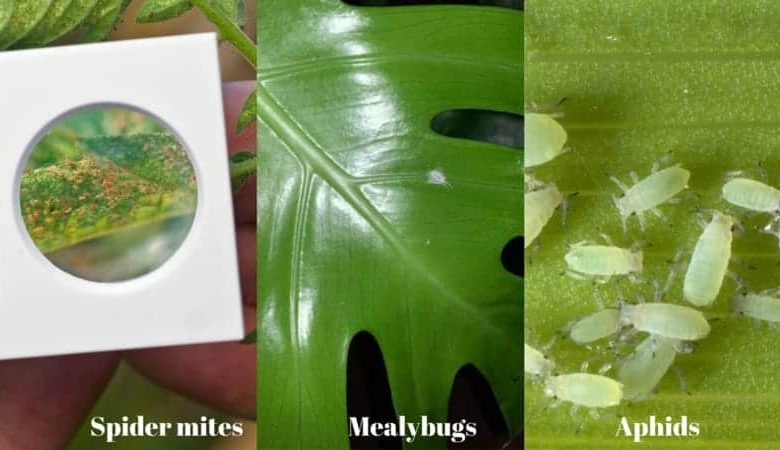
It is very normal for bugs to appear on the leaves of the plants in your garden. We already know that the term «bugs» is not technically correct, but it is also true that it is a word that is commonly used to refer to various types of small insects such as aphids of all kinds, small beetles, ants and also refer to mites like the red spider or the white spider.
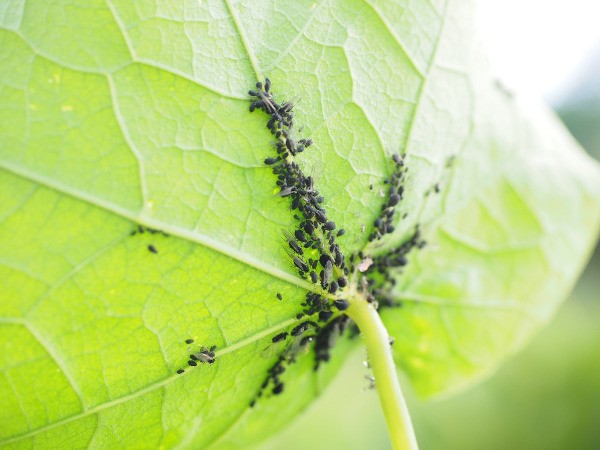
This article arises from a query from my friend Daniel who recently sent us this image of a plant:
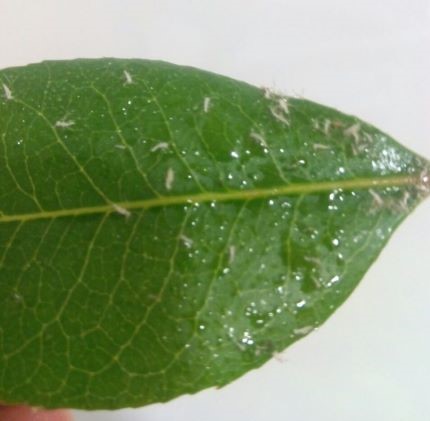
Leaf Bugs: What are they?
The image is not of the best quality, but we do appreciate a leaf from a tree, which appears to be rosacea, something similar to small white bugs surrounded by a transparent liquid that appears to be molasses. It is difficult to give a verdict one hundred percent assuring what type of plague it is, since from a distance and through a photo the challenge becomes much more difficult, but in this case, after giving it a few thought, we think that it is aphids, but… not from live aphids, but from their molts.
But what is the moult? Molting is a process that takes place in many insects during their development in the juvenile state and that consists of getting rid of the exoskeleton (a continuous external skeleton that covers, protects and supports the body of the insect) which, being hardened, does not allow the insect grow so they shed it to be able to do it. The shed exoskeleton remains as a residue on the leaves, and therefore makes us doubt what kind of insect we have, since they have the external shape of, in this case, aphids, but it is “empty inside”. In any case, even if there were no aphids at that time, the remains of the molt and the molasses have helped us to know what type of insectit had been feeding on that leaf.
Aphids are some of the «bugs» that we can find in our crops, but there are many more, and not all of them have to be harmful, some can help us fight other pests, and they are what we know as natural enemies. So let’s make a brief summary of these «bad bugs» that we can see on the leaves of our crops.
The most common bugs on plants
These are some of the most common pests that can be found on garden plants and garden ornamentals.
aphids on plants
For me they are the easiest to recognize for several aspects. First of all, all stages of development are very similar, only their size varies.
They are small bugs (no more than a few millimeters), mostly green, yellow or black. The body of aphids is soft and globular in shape and they can be wingless (wingless) or winged. In this case they have two pairs of relatively small and transparent membranous wings. Secondly, there are the siphons or cornicles, a pair of erect trumpet-shaped appendages located at the end of the abdomen that can be easily seen against the light, through which they pour substances and pheromones with different functions, among which is that of repelling to their natural predators.
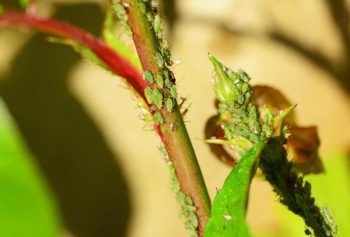
On the other hand, there is molasses, a sugary and sticky secretion that is expelled through the anus as a product of digestion, so where there are aphids, there is normally molasses.
ants and aphids
And finally, we have the ants, your faithful allies. In evolution, aphids have developed an almost symbiotic relationship with ants, which not only tolerate them on plants, but also protect them from their predators, beneficial insects such as ladybugs or lacewings, in exchange for the secretion of molasses that they It serves as food, so if you see ants and doubts, they are surely aphids.
Direct damage caused by aphids is due to the wounds produced by sticking the stylet (needle-shaped mouthparts) into the tissues to feed and the absorption of plant sap, producing generalized weakening, reduced growth and yellowing of the plants. the plant. But more important still are the indirect damages.
The molasses serves as a support for the «black», a dark-colored fungus that reduces the photosynthesis process and depreciates the fruits. In addition, aphids are vectors of a large number of viruses that they transmit to plants when they feed.
In this article you can discover more about aphids and how to eliminate them in an ecological way.
whiteflies on leaves
They are not really flies, but they are so named because of their similarity to them. They are very small and white in color, including their two pairs of wings.
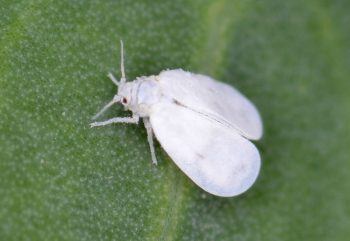
Normally, they prefer the underside to the upper part of the leaves, and if they are very green, that is, they have a lot of nitrogen, all the better. The damage they cause is almost the same as that of aphids, and in this case their ability to transmit viruses to the plants they attack is also very important.
There are several ecological methods to eliminate the whitefly plague, but one of the most effective is the use of yellow traps. These traps can capture hundreds of whiteflies in just a few hours.
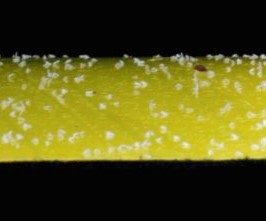
White bugs on plants: Mealybugs
These insects vary greatly in appearance, from very small organisms (1-2 mm) with white, powdery covers, to shiny balls of about 5 mm and covered with honey wax, although they are very easy to identify.
While the males do not feed on plants and have wings, the females (which are the ones we see in our crops) are larviform and lack wings and are permanently attached to the plants they parasitize. In addition, they secrete a wax coating for their defense in the form of a shield, the shape of which varies according to the species.
The damage caused is similar to the previous ones, except for the transmission of viruses. In this case, the appearance of «bold» due to the excretion of molasses is more important.
At a commercial level, the aesthetic damages, such as discolorations, that they cause in the fruits are important. In this post you can read ecological remedies to eliminate the cottony cochineal plague.
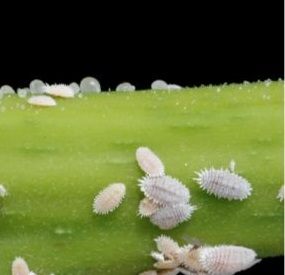
Psilas
It is one of the most difficult bugs to identify. The adult is shaped like a very small winged lobster, with a very bulky head.
The nymphs (juvenile stage) have a flattened shape and are light yellow when they hatch, but turn green as they grow. The females lay a large number of eggs, so they can have several generations a year.

Black bugs on plants: Thrips
Surely you have all caught a daisy in the field and it had some very small black «bugs» running around on it, because those are the thrips. They are small-sized insects (1-6 mm), cylindrical in shape, elongated and with a very sharp posterior end.
They are brown or black in color and there are wingless (wingless) and winged species. In the latter case the wings are very narrow, and surrounded by filaments, as in the form of fringes, which give them the appearance of feathers. The thrips give us one of lime and one of sand. On the one hand, some species are pests due to the damage they cause by feeding on flowers or vegetables, discoloring them or producing deformities that make them less profitable.
Additionally, these tiny little critters can act as vectors for more than 20 viruses, including some of the most damaging viruses, such as tomato wilt virus. However, many others serve as natural enemies and help us fight against other harmful insects.
In this post I wrote about flower thrips you can find some of the most used remedies to kill plant leaf thrips and avoid serious damage.
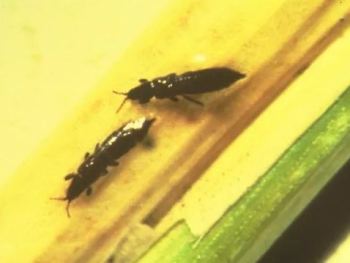
Bedbugs
These insects have mouthparts forming a beak-like structure called a rostrum adapted to pierce and suck liquids from plants. In general they have two pairs of wings, where the previous ones, called hemilytra, have one half hardened and the other half membranous, a characteristic that differentiates them from other groups of insects. Like thrips, bed bugs can be pests or great allies that devour other harmful insects.
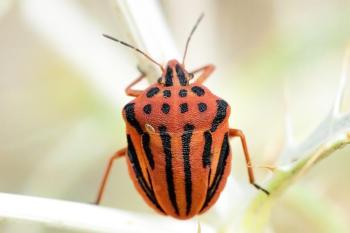
References
- Healey M, Senior L, Brown P, Duff J (2017).Relative abundance and temporal distribution of adult Frankliniella occidentalis (Pergande) and Frankliniella schultzei (Trybom) on French bean, lettuce, tomato and zucchini crops in relation to crop age. Journal of Asia-Pacific Entomology, 20(3), 859-865.
- Abrol, D., Shankar, U. (2016).Chapter 20-Integrated Pest Management. Editor(s): Surinder Kumar Gupta, Breeding Oilseed Crops for Sustainable Production. Academic Press, 523-549.
- Riley, D., Sparks, A., Srinivasan, R., Kennedy, G., Fonsah, G., Scott, J., Olson, S. (2018) Chapter 3 – Thrips: Biology, Ecology, and Management. Editor(s): Waqas Wakil, Gerald E. Brust, Thomas M. Perring, Sustainable Management of Arthropod Pests of Tomato. Academic Press, 49-71.
These are just some of the «bugs» that we can find. I have chosen the most visible ones, either because of their size, because they come out during the day or because they gather in large groups that are easier to see; however, there are many more, more difficult to see and identify, although we will try to talk about them in future articles as well. I hope it helps you!




